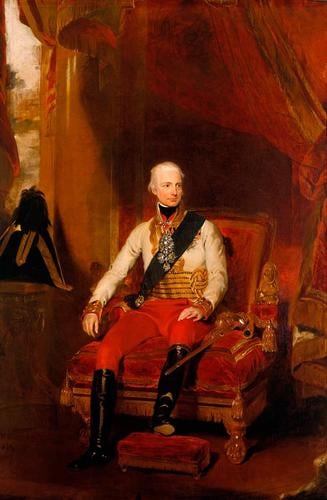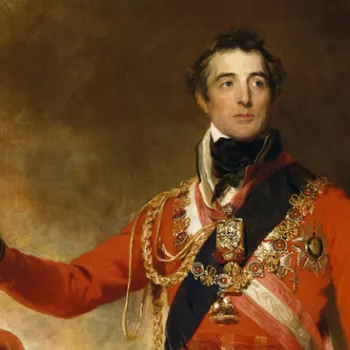Francis I, Emperor of Austria (1768-1835) 1818-19
Oil on canvas | 271.5 x 179.4 x 4.5 cm (support, canvas/panel/stretcher external) | RCIN 404943
-
Thomas Lawrence was the most fashionable portraitist of his generation in Britain. He was made Principal Painter to George III in 1792 after Sir Joshua Reynolds’s death, and received occasional commissions; however it was only after 1814 that George IV began to employ him in earnest.
This portrait of the Emperor of Austria was commissioned by George IV at a cost of 500 guineas. Lawrence ventured across Europe to undertake the King's commission of a group of portraits of the allied military and political leaders involved in the Napoleonic Wars. Although Lawrence met the Emperor during the Congresses of Aix-la-Chapelle and Vienna in 1818-9, the dates during which he undertook this painting itself are not known, as it remained in the artist's studio at his death in 1830. The Emperor is shown in military uniform with his plumed hat on a table beside him; the riband and star of the Order of the Garter worn under that of the Golden Fleece. In addition to enabling him to render details of military dress with accuracy, the artist attached particular importance to capturing his sitters from life, in order to imbue a sense of liveliness. The Emperor’s countenance, he described as 'rather long and thin, and when grave, is grave to melancholy; but when he speaks, benevolence itself lights it up with the most agreeable expressions, and making it the perfect image of a good mind.’ (letter of 5 November 1818).
The conception of this group of twenty-eight portraits began in 1814 when George IV used the opportunity of the Treaty of London to commission Lawrence to paint a number of the King's distinguished visitors. The group of portraits grew during the next decade as Lawrence continued to obtain portrait sittings at the various congresses following the Battle of Waterloo in 1815 and, in some cases, by making special journeys. Most of the portraits were delivered after his death on 7 January 1830. By this time work had already begun on the construction of the room, now known as the Waterloo Chamber, where we know that the King intended to hang these works. The room was created by covering a Medieval courtyard at Windsor Castle with a huge sky-lit vault; though this feat was only completed during the reign of William IV (1830-7). The first illustration of the interior is provided by Joseph Nash (1809-78) in 1844 (RCIN 919785) and shows the arrangement which survives to this day: full-length portraits of warriors are hung high over the two end balconies and around the upper part of the walls; while at ground level full-length portraits of monarchs alternate with half-length portraits of diplomats and statesmen.Provenance
Painted for George IV for 500 guineas; added to the inventory of Carlton House dated 1819 (no 647); taken to the Waterloo Chamber at Windsor Castle, where it appears in Joseph Nash's watercolour of 1844 (RCIN 919785)
-
Creator(s)
Acquirer(s)
-
Medium and techniques
Oil on canvas
Measurements
271.5 x 179.4 x 4.5 cm (support, canvas/panel/stretcher external)
266.5 x 175.5 cm (sight)
264.5 x 173.5 cm (sight)
Category
Object type(s)









